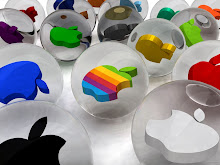Since our lecturer wants us to explore something does not discuss deeply in the blog, and she give us some ideas about the topic we can discuss. So, i would like to choose the topic' how does the touch-screen works? ' This is because i am interested in this topic and i got the experience to use the iPhone. I found that if i use my fingernail to touch the screen, i could not get the sensor. I need to use my fingertip to touch the sceen just can get the sensor.
Why You Can Only Touch With Your Finger
Most other touch screen devices allow the use of a stylus, or at least the touch screen can function when you touch it with something besides your finger. But with the iPhone, you have to touch the screen with your finger. This is because the iPhone can have a capacitor at every point on the screen only because each capacitor relies on feedback from the electricity in your finger to operate. When you touch the screen, the screen at that point senses the natural capacitance of your body (your body's ability to hold an electrical charge) and then registers a change in current at that point on the screen. If you use a stylus to touch the iPhone's screen or touch it with a gloved hand, the iPhone will not be able to pick up any natural capacitance and so it won't know you're touching it there.In reality, the iPhone has one half of a capacitor at every point on the screen. The other half of the capacitor is your finger. Together, the circuit beneath the glass cover and the capacitance in your finger change the electrical charge at that point on the screen.
I would like to discover more about the multi-touch in iPhone.
Each position on the iPhone's screen can independently pick up a touch. This means that you can touch the screen in more than one place at a time, and the iPhone will register all touches. Apple used this multi-touch feature in many of the applications and software on the phone. For example, when you are using a maps application or browsing your pictures on the phone, you can make a pinching motion on the surface of the screen and that gesture will zoom the image out. If you want to zoom in, you start with your fingers together on the screen's surface and then pull your fingers apart and watch as the application zooms in on where you first touched the screen.
References from http://www.ehow.com/how-does_5220915_do-iphone-touch-screens-work_.html
If you want to know more about the topic, you may search from the web.
Since i found that the function of touch-screen in iPhone and iPod are almost similar, so i would also like to share about the infomation i found from Internet.
When you touch the screen, the iPod's circuitry detects the presence of your finger. It keeps track of how many fingers you have on the screen and where you move them. It also gives the iPod touch the capability of running apps. The iPod touch does this using a layer of capacitive material under a protective covering. You can read How Capacitors Work to learn more about them, but the basic idea involves taking advantage of the electrical properties of the human body. When you touch a capacitive surface, the amount of charge it holds changes. This is why devices like the iPod touch require you to touch them with your bare skin -- insulating materials like gloves, pens and styluses don't cause the same changes in the capacitive circuitry.
The basic process behind detecting touch
There are two possible methods the iPod touch can use to measure changes in electrical states:
- Self capacitance: Circuitry monitors changes in an array of electrodes.
- Mutual capacitance: A layer of driving lines carries current. A separate layer of sensing lines detects changes in the electrical charge when you place your finger on the screen.
Regardless of which method the screen uses, you change the electrical properties of the screen every time you touch it. The iPod records this change as data, and it uses mathematical algorithms to translate the data into an understanding of where your fingers are.
references from http://electronics.howstuffworks.com/ipod-touch2.htm
After that i found another interesting question:
Why does ipad touch-screen work with fingernails but droid does not?
Both the iPad and Droid use capacitive touch screens, which work by sensing the disruption of the electric field at the surface of the screen by a conductive object (i.e. your finger). Neither of them should really work with a fingernail, as the nail isn't really conductive - I would guess that the reason the iPad picks up input from your fingernail is because its screen is more sensitive (probably because it is much larger), and therefore just having your finger near the screen (at a fingernail-length distance away) is enough to register without actually needing you to contact the surface.






0 comments:
Post a Comment